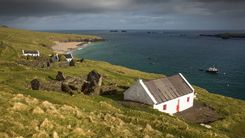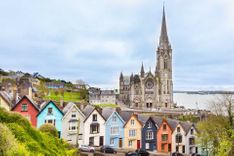#8: The Ring of Kerry
Best for: First-time visitors seeking classic Irish scenery
Duration: 111 miles (179 km) loop, 1 full day
The Ring of Kerry is one of those classic drives that gives you a bit of everything—coast, countryside, mountains, and small towns—without needing to go too far. It’s a 111-mile (179-kilometer) loop around the Iveragh Peninsula in southwest Ireland, and it’s a great introduction to the landscape here.
The road takes you past wide beaches, high cliffs, green hills, and through valleys dotted with sheep and stone walls. You’ll also come across old stone forts, early Christian ruins, and the remains of villages from the famine years.
Towns like Kenmare, Sneem, and Waterville make easy stopping points along the way.. For big views, pull over at Moll’s Gap and Ladies View—both look out across Killarney National Park and the lakes below.
It gets busy in summer, especially with tour buses, but it’s well set up for visitors and easy to follow. You can drive it in a day, but it’s worth stopping often to take in the views or just stretch your legs. For more advice, see our Ireland travel tips.
How to get to the Ring of Kerry
Most people start the loop in Killarney, but you can pick it up anywhere along the route. If you’re driving from Dublin, it takes about 3.5 hours via the M7/N22. From Shannon Airport, it’s closer to 2 hours via the N21/N22.
It’s common to drive it counterclockwise—starting in Killarney and heading toward Killorglin—because that’s the direction the tour buses take. It helps avoid awkward encounters on narrower roads.
The full loop takes about 7 to 8 hours with stops. If you’re short on time, focus on the southwest section between Waterville and Kenmare—it’s the most dramatic stretch.
When to visit the Ring of Kerry
Late spring through early fall (May to September) is generally the best time for daylight and weather. July and August are the busiest, but they also tend to have the driest, clearest days. Expect temperatures between 59–68°F (15–20°C).
For fewer crowds, consider May, June, or September. The weather is usually still decent, but towns and viewpoints are less packed and it’s easier to book places to stay (see our guide to Ireland accommodation for more advice).


















